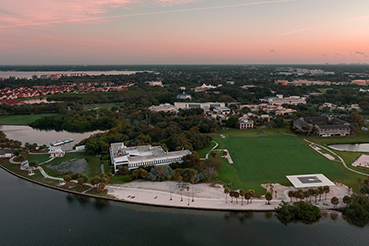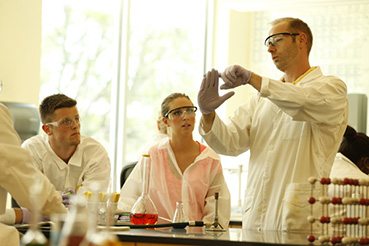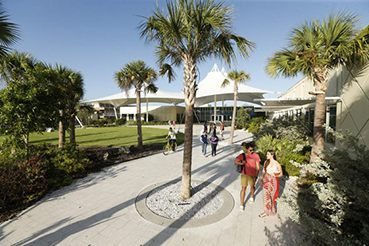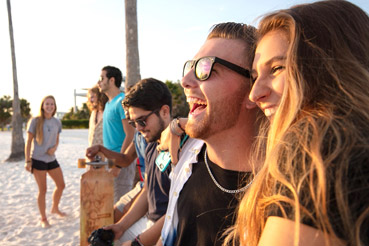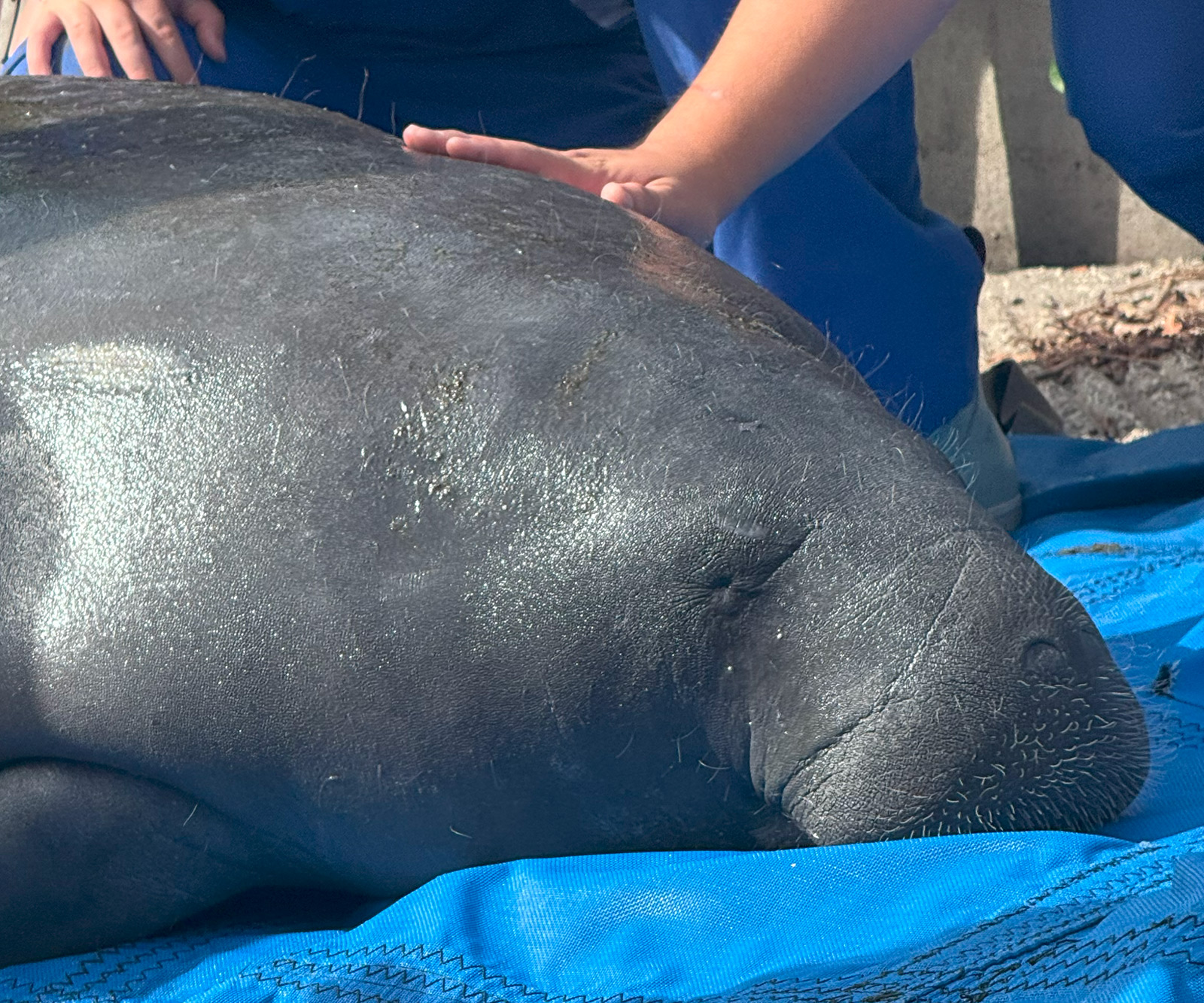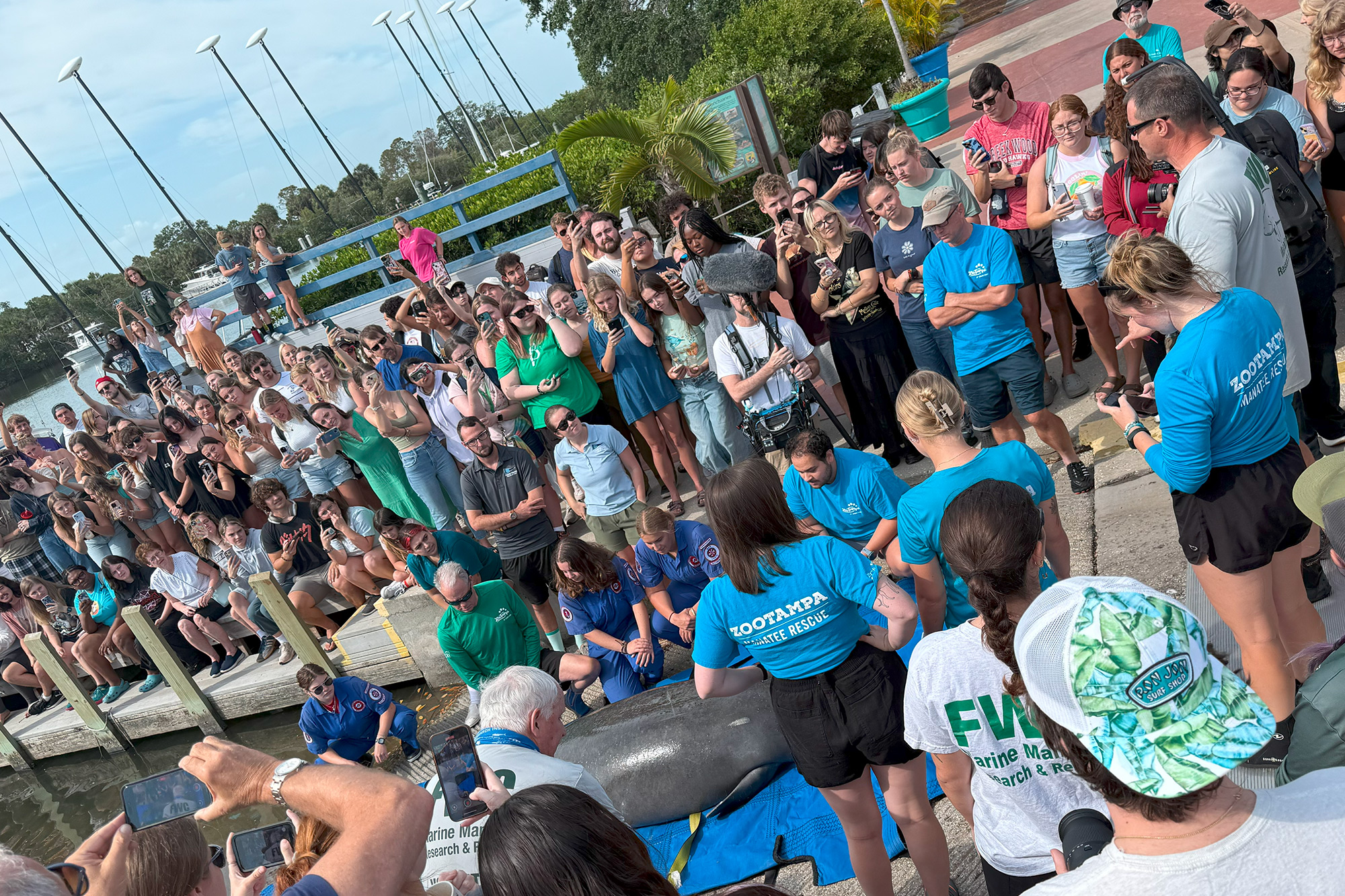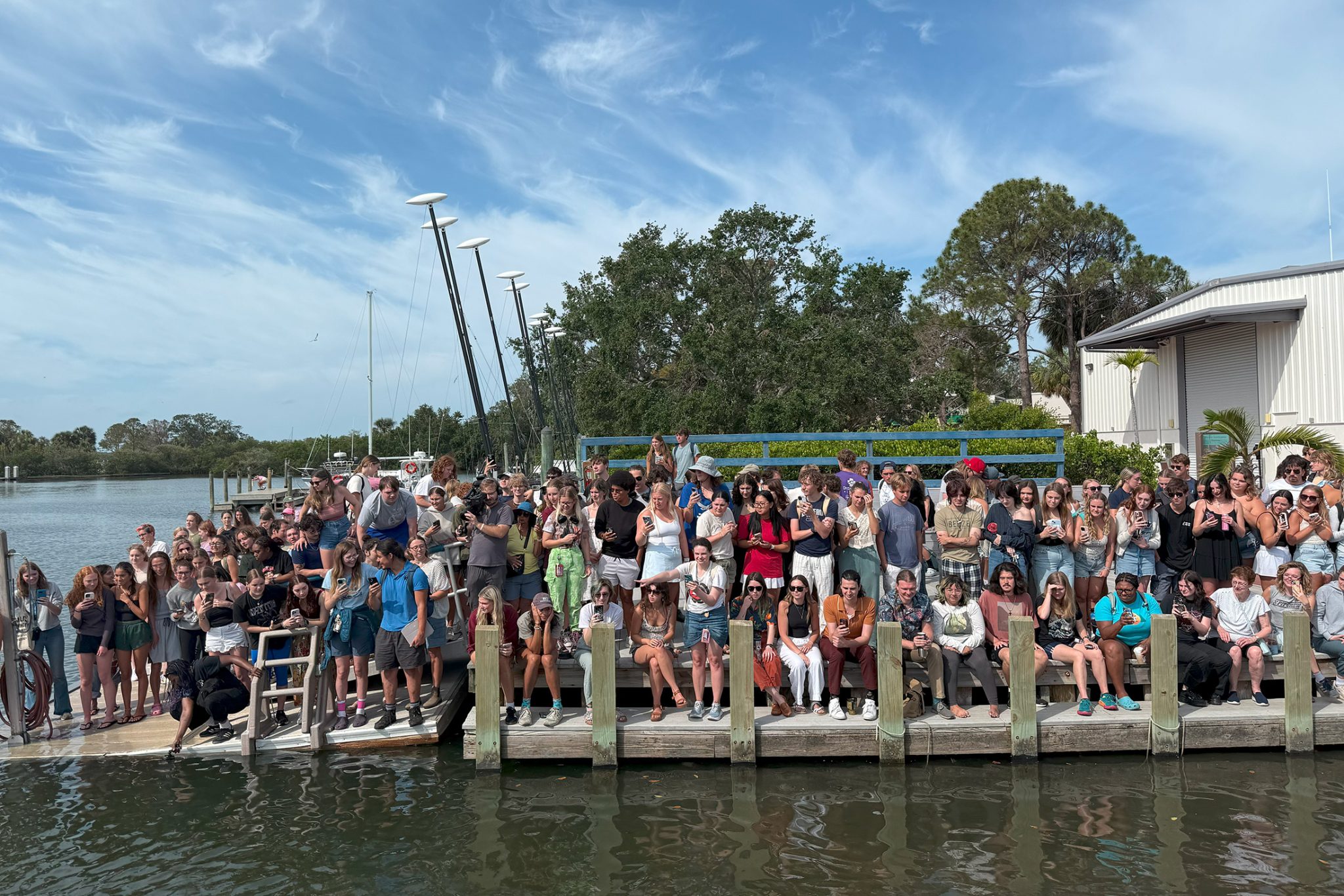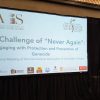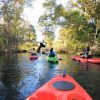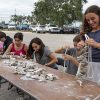An aerial view of the release of Seagull the manatee; video by Penh Alicandro ’22, photos by Michel Fougères
It took 17 people, many of them students from Eckerd College, to lift and carry an 875-pound, 8-foot-4-inch-long adult female manatee named Seagull from the back of a ZooTampa at Lowry Park rescue truck to the boat ramp at the Eckerd College Waterfront Complex on Frenchman’s Creek.
The transfer went quickly. About five minutes after she was placed on the ramp, Seagull was lifted up again and gently eased into the water.
Moments before her departure, the College announced an expanded collaboration with the Florida Fish and Wildlife Conservation Commission that will, for the first time, include training Eckerd students to provide detailed assistance in future rescues.
Seagull had been rescued February 6 in Boca Ciega Bay near Gulfport by crews from the Eckerd College Search and Rescue Team and the FWC. She was suffering from cold stress; the water temperature of the bay that day was about 63 degrees. Manatees are susceptible to cold stress, similar to hypothermia, when water temperatures drop below 68 degrees. Despite their rotund appearance and unlike whales, walruses and sea lions, manatees don’t have a thick layer of blubber to insulate them. After her rescue, Seagull spent the next three months rehabilitating at ZooTampa before she was cleared for release.
As she began to swim away from the ramp, she nudged her head above the surface, as if to let the more than 200 people who had come to say goodbye know she was safe. Then she flipped her tail and disappeared into the creek, not far from where she’d been rescued. On cue, everyone let loose a cheer.
Seagull’s release on May 1 wasn’t the only reason to celebrate at the Waterfront. For the past decade, EC-SAR has assisted the FWC in the rescue of at least six manatees. That usually involved helping to locate the animal and then assisting in its transfer to an FWC boat. Now, however, more sophisticated help is on the way.
Starting during Autumn Term of this year, in August, EC-SAR Team members will be trained by the FWC to relay detailed information about an injured or sick marine mammal’s condition—be it a manatee, dolphin or whale—and then remain on-scene to assist in the capture and transfer of the animal to an FWC boat.
Already a highly trained group of student volunteers that works closely with not only the FWC but also the U.S. Coast Guard, 911 Emergency Medical Response, and other state and local agencies—EC-SAR answers about 500 maritime distress calls every year and is one of the most unique cocurricular programs available to full-time, degree-seeking Eckerd students. No other baccalaureate institution in the U.S. has a program like it.
The team was founded in 1971 in an effort to provide safety services for the College’s watersports activities. In 1977, EC-SAR extended its free rescue services to the Tampa Bay boating community, although donations to the student club are welcome. Members volunteer 12–15 hours each week for training, meetings and equipment repair. In addition, students are on call for one 24-hour period every three days. They patrol the waters of Tampa Bay on weekends, and they monitor radio calls during the evenings. For the 2024–25 academic year, there were 61 team members.
Ryan Dilkey ’98 is associate director of the Waterfront Program and director of the Eckerd College Search and Rescue Team. “We’ve had a really good, long-standing relationship with the FWC,” he explains, adding that he and Andy Garrett ’99, a manatee rescue coordinator for the FWC and head of the FWC’s Marine Mammal Pathobiology Lab on Eckerd’s campus, were students together at Eckerd. “And with the lab on campus, we’ve maintained that collaborative relationship over time.
“We’ve always been looking at the future of the Waterfront and how we can grow our abilities to improve and expand our support of the College’s academic programs,” Dilkey says. “We will strengthen our relationship by receiving training that will better prepare students to assist in animal rescues, retrievals and releases. In addition, we will also learn what type of information is needed for an initial report of a distressed animal. We will then be able to gather information the FWC has trained us to look for—all the things they would want to know so they can evaluate on their side the next best steps regarding that animal.”
The training also will include releasing marine mammals. “You’d think releasing a manatee like Seagull doesn’t take a lot of training, but it does,” Dilkey adds. “Why is a manatee brought out of the truck tail first? Where do you take measurements? The students will be trained to be a better-equipped aide.
“One of the main goals is for the students to graduate and be successful in what they do next. This work could certainly be a feeder into the FWC employment but also into other field biology opportunities, lab work … to have a mechanism in which you go out on boats, have hands-on experience rescuing marine mammals and then releasing them; it’s a pretty remarkable thing to provide an undergraduate. It’s a win, win, win—for the students, the FWC and the manatee.”
Garrett says the smooth transfer of Seagull from the truck to the water also had to do with where she was released. “You never know how a manatee will react, but Seagull seemed pretty chill and calm,” he says. “This is why Eckerd is a nice spot to do the release. Across the water, the Maximo Boat Ramp was pretty busy. The Eckerd ramp was quieter, so the manatee could calibrate itself and move on.
“This is something we’ve wanted to do for a long time,” Garrett adds, “to find ways to get students involved. Seagull’s rescue is a perfect example. Someone from the public reported a sick manatee, I called Ryan, and he said he had the support staff and a support boat. Our focus is to bring them [EC-SAR students] in whenever they have an opportunity. It makes it a lot easier.
“When I first started with FWC in 1999, we worked almost entirely with law enforcement. But as they have had to draw back to fulfill other obligations, having Eckerd step in and fill some of the roles is great.”
Renee Register, director of Eckerd’s Waterfront Program, has been working at the Waterfront in some capacity since she graduated from the College in 1983. “This is a great way for us to formalize what we can do,” she says. “More and more students are interested in EC-SAR, and we’re always asking what else can we offer the students and how can we help them grow and learn and leave here with experience they can use. Now, with additional FWC training, it adds another element.
“We’re all so excited to be able to do it,” adds Register, who plans to retire next year after 46 years at the Waterfront. “It provides additional benefits and unique opportunities for our marine science and animal studies students, and releasing a manatee is such a positive thing. It just gives people a smile.”
People like Carly Dehn, a sophomore marine geology and Spanish student from Scottsdale, Arizona, who was one of the 17 people who helped carry Seagull. Carly joined EC-SAR last year after seeing team members running to answer a call. “I found out who they were and what they were doing,” she says. “I immediately joined, and I never looked back.
“Being from the desert, we don’t see that many manatees. So it’s really cool to be given the opportunity to assist in a rescue or a release.” And when Seagull popped her head out of the water?
“It was like she was thanking us,” Carly answers. “She turned to see everyone watch her go. It was magical. I’m going to be working in marine geology, and having experiences like that with these animals gives me perspective on how we approach research in the future. And the fact that I’m doing this as an undergraduate, I’m so grateful.”
A gentle, slow-moving mammal whose closest living relative is the elephant, an adult manatee can weigh as much as 1,200 pounds and live as long as 65 years. Manatees are Florida’s official state marine mammal and are listed as a threatened species.
They lead a tough life. They can fall victim to boat strikes, starvation from habitat destruction, cold stress, and toxic red tide algae outbreaks, among other perils. The current Florida manatee population is between 8,350 and 11,730, according to the FWC.
And their future is uncertain. The number of manatee deaths documented by the FWC in 2021 was a record 1,100, but the numbers have since declined. In 2024, the number of deaths was down to 565. As of May 2 this year, however, 344 deaths have already been documented.

